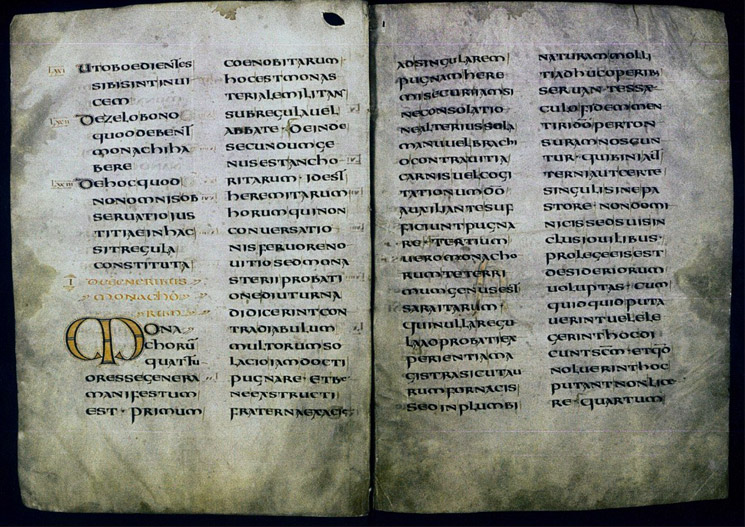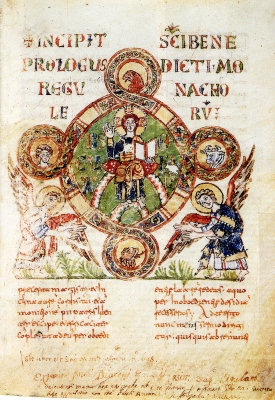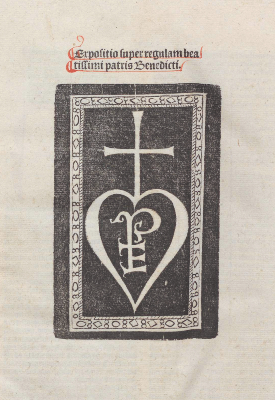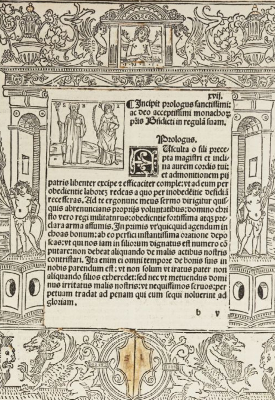Monastic rules
and the Rule of St Benedict
Inspired by Scripture and monastic tradition, the Rule of St Benedict contains the essence of Benedictine spirituality and their life as a community. It lay at the root of the development of monasticism in the West.


Early forms of monastic life and the Benedictine Rule
The creation of a rule which defines the spiritual life of a community, its prayers and the other activities into which the days are divided, generally under the direction of a superior known as the Father or Abbot is characteristic of the earliest anchorite communities both in the East (where such communities were first formed) and the West. The oldest known rules are those devised by Pachomius and Basil (in the East, 3rd-4th centuries), of Caesarius of Arles (5th – 6th centuries) – which were written for a convent – and the rule known as the Regula Magistri (in the West, 6th century).
The creation of the rules drawn up by St Benedict to govern the life of the community he founded in Montecassino dates to the first quarter of the 6th century. The Rule defines every aspect of the monks’ communal life. The Rule spread rapidly to the monasteries in Terracina and Subiaco, where some of Benedict’s disciples had formed communities and eventually became the foundation of Western monasticism. From the 9th century onwards it spread throughout Europe thanks to the reforms introduced by the abbot Benedict of Aniane and in the context of the political and ecclesiastical reforms pursued by Charlemagne.
The Regula is followed as a unique rule for the discipline and liturgical activity of the community in monasteries in most of Europe. It is composed of a preface and 73 chapters and provides precise instructions for the daily life of a monastery, its rituals and activities, and the duties of the monks, beginning with the abbot. St Benedict took his inspiration in writing the Rule from Holy Scripture, the monastic traditions of his day, both in the East and West, and from the writings of the Church Fathers.
1. Listen, my child, to the precepts of your master and incline the ear of your heart. Receive willingly your father’s admonitions and be sure to act on them
2. so that by the effort of obedience you may return to Him from whom you retreated through idle disobedience.
The text of the Regula
The Prologue to the Regula Sancti Benedicti opens with a summons to listen, to order, discipline and obedience. In the text which follows, duties and prohibitions alternate. The opening chapters define the qualities and virtues of a monk, of the abbot, and what should characterise the community. These are followed by rules on prayer. Then there are rules on other aspects of monastic life, daily tasks and meals, work and the welcoming of guests. Obligations, prohibitions and punishments are all spelt out in detail.
In the organisation of the community’s daily life, the Rule dedicates much time to the activity of reading, though there isn’t one single chapter on the rules for this. As a young man Benedict had been brought up in Rome and had a very clear sense of how important it was for monks in his community to acquire a certain level of education. Monks needed to be able to read in order to be able to pray – prayer were recited and chanted – as well as for their spiritual development.

In a Benedictine monastery, outside the liturgy of the hours, time is assigned for reading both on one’s own and as a community. This reading was not only of Biblical texts but also spiritual writings, the works of the Church Fathers and the lives of the martyrs. In Chapter 4 on the Instruments of Good Works, the rule asks monks:
[…] to listen willingly to the reading of the word of God, to dedicate oneself frequently to prayer
An entire chapter of the Rule (Chapter XXXVIII) is about the readings which take place in the refectory:
During the monks’ mealtimes there should always be reading. It is not allowed that any monk can take any book and chance and read; there must be a monk whose duty it is to read and who reads for the week beginning on Sunday […] Complete silence must be kept in the refectory without a murmur or sound of any voice except that of the reader […] the duty of reading at mealtimes must be given only to those who are capable of edifying those who listen.
It is also allowed for the monks to gather after supper and before Compline to listen to readings (Chapter XLII):
…the monks may gather together while one of them reads the Conferences [of St John Cassian] or the Lives of the Church Fathers or some other edifying work…
But the Rule also allows for individual reading, as Chapter XLVIII on daily work makes clear:
… 13. After lunch the monks may spend the time reading individually or studying the Psalms. 14. During Lent they may read from dawn until past 9 in the morning after which they must carry out the work required of them until 4 in the afternoon. 15. During Lent each monk receives a book from the library which he must read in order from beginning to end. 16. The aforesaid books must be distributed at the beginning of Lent. 17. At the beginning of this period one or two of the more elderly monks should be given the task of going round the monastery during the hours when the brothers are studying, 18. in order to see if by chance there is an idle monk who, instead of studying, is wasting his time by idling and chatting, and therefore not only spending his own time unproductively but distracting others too.
The books in the monastery belong to the community. In Chapter XXXIII on the “vice” of owning things St Benedict stipulates that:
[no-one] should think of possessing anything of his own, not a single thing, not a book, or a notebook, or a sheet of paper, not even a pencil…
Among “the things which are strictly necessary” and which the abbot must distribute to the monks as need arises are also writing instruments:
…But, in order to root out this vice of possession, the abbot must distribute everything that is necessary: scapular, habit, socks, shoes, belt, knife, needle, handkerchief, and writing equipment, so that no-one can claim he needs anything.

The “humanistic” education of monks
Meditation, prayer and spiritual edification were among the duties expected of a monk and reading was an indispensable element in carrying out these activities. As part of monastic life, the Holy Scriptures were read (selectively and not at all periods of the year), but other reading matter included lives of the martyrs and the works of the early Christian theologians such as Ambrose, John Cassian, Leo the Great… This “use” of reading and of writing in monastic life required a knowledge of Latin grammar and literature and the monks from their first entrance into the community must have been taught these subjects continuously. In this way pagan classical texts entered the monastery since they were necessary tools to learn Latin grammar.
EDITIONS
Manuscript editions of the Rule
The earliest surviving manuscript of the Rule is the codex Hatton 48, in the Bodleian Library in Oxford, which dates from the 7th to 8th centuries. In the monastic libraries which form part of the national monuments in Italy there are early and often precious manuscript copies of the work, such as Casin. 175, the earliest illustrated copy of the Rule.



